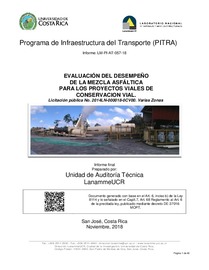Evaluación del desempeño de la mezcla asfáltica para los proyectos viales de conservación. Licitación pública No. 2014LN-000018-0CV00. Varias zonas.
Date
2018Author
Fonseca Chaves, Francisco
Cervantes Calvo, Víctor
Guerrero Aguilera, Sergio
Herra Gómez, Luis Diego
Metadata
Show full item recordAbstract
SOBRE LA DEFORMACIÓN PERMANENTE DE LA MEZCLA ASFÁLTICA PRODUCIDA:
Algunas de las muestras ensayadas mediante deformación permanente (APA) presentan valores iguales o mayores al valor de referencia utilizado para capas de superficie de ruedo, siendo el 25% para mezcla de TM.12 mm y el 75% para la mezcla de TM.19 mm.
SOBRE LA DEFORMACIÓN RUEDA DE HAMBURGO DE LA MEZCLA ASFÁLTICA PRODUCIDA:
Ambos tipos de mezclas no se ven afectadas a la susceptibilidad al daño por humedad. Por su parte las mezclas de 19 mm evidencian ser más propensas a la deformación permanente, ya que el 40% de las muestras ensayadas presentan resultados mayores al valor de referencia utilizado. En tanto solamente el 13% de las mezclas de 12mm superan dicho valor. Además, se observa que la mezcla de 19mm es más propensa a la deformación, ya que es hasta un 84% más deformable que la de 12mm.
SOBRE LA FATIGA DE LA MEZCLA ASFÁLTICA PRODUCIDA:
En cuanto a la resistencia a la fatiga se denota que el 85% de las mezclas con asfalto original analizadas (12mm y 19mm) no logran cumplir ambos criterios simultáneamente de la especificación de referencia, al ser comparadas con el criterio de mezcla tipo C y D. También se observa que en 2 casos la mezcla de 19mm reporta una mayor resistencia a la fatiga que los valores de referencia y particularmente aventaja a la mezcla de 12mm.
SOBRE EL MÓDULO DINÁMICO DE LA MEZCLA ASFÁLTICA:
El valor de módulo dinámico de las mezclas de 12mm y 19mm fue determinado a partir de las curvas maestras de cada una de las mezclas. Luego se determina para una condición de frecuencia de 10 Hz y tres temperaturas de análisis (10ºC, 25ºC y 34ºC), encontrándose que el de 19mm es aproximadamente un 20% menor que el registrado en las mezclas de 12mm. También se evidencia que el valor determinado (valor real) del módulo de las mezclas es entre un 60% a 70% mayor al valor utilizado en la metodología AASTHO para el diseño de las capas que componen el paquete estructural.
SOBRE EL DESEMPEÑO DE LA MEZCLA ASFÁLTICA:
Se evidencia que existe una relación directa entre la cantidad de asfalto efectivo presente en la mezcla y la cantidad de ciclos, tal como indica la literatura, que puede soportar una capa asfáltica, antes de alcanzar la fatiga. Asimismo, se observa que al aumentar la cantidad de asfalto en la matriz pétrea -consecuentemente los vacíos disminuyen- la carpeta se vuelve más deformable, ya que con una menor cantidad de ciclos se logra alcanzar la deformación permanente. También se determina que, para las muestras analizadas, conforme hay menor cantidad de asfalto, el módulo dinámico de la mezcla aumenta. Finalmente, se establece que la capacidad de resistencia a la deformación se disminuye aproximadamente en un 20% por cada grado centígrado que aumenta la temperatura de la carpeta asfáltica ON THE PERMANENT DEFORMATION OF THE PRODUCED ASPHALT MIXTURE:
Some of the samples tested by permanent deformation (APA) have values equal to or greater than the reference value used for surface layering, being 25% for mixing TM.12 mm and 75% for mixing TM.19 mm.
ABOUT THE DEFORMATION BY HAMBURG WHEEL TRACKING OF THE PRODUCED ASPHALT MIXTURES:
Both types of mixtures are not affected to susceptibility to moisture damage. On the other hand, the 19 mm mixtures are more prone to permanent deformation, since 40% of the tested samples present results higher than the reference value. Only 13% of the 12mm mixes exceed this value. In addition, it is observed that the 19mm mixture is more prone to deformation, since it is up to 84% more deformable than the 12mm.
ABOUT THE FATIGUE OF THE PRODUCED ASPHALT MIXTURE:
Regarding fatigue resistance, it is noted that 85% of the original bitumen mixtures analyzed (12mm and 19mm) fail to meet both criteria simultaneously from the reference specification, when compared to the mixing criteria type C and D. It is also observed that in 2 cases the 19mm mixture reports a greater resistance to fatigue than the reference values and in particular it exceeds the 12mm mixture.
ON THE DYNAMIC MODULUS OF THE ASPHALT MIX:
The dynamic modulus value of the 12mm and 19mm mixtures was determined from the master curves of each of the mixtures. Then it is determined for a condition of frequency of 10 Hz and three temperatures of analysis (10ºC, 25ºC and 34ºC), finding that the 19mm is approximately 20% lower than that registered in the 12mm mixtures. It is also evident that the determined value (real value) of the module of the mixtures is between 60% to 70% greater than the value used in the AASTHO methodology for the design of the layers that make up the structural package.
ON THE PERFORMANCE OF THE ASPHALT MIX:
It is evident that there is a direct relationship between the amount of effective asphalt present in the mixture and the number of cycles, as indicated in the literature, which can support an asphalt layer, before reaching fatigue. Also, it is observed that by increasing the amount of asphalt in the stone matrix - consequently the voids decrease - the folder becomes more deformable, since with a smaller number of cycles it is possible to reach permanent deformation. It is also determined that, for the samples analyzed, as there is less asphalt, the dynamic modulus of the mixture increases. Finally, it is established that the capacity of resistance to deformation is reduced by approximately 20% for each degree centigrade that increases the temperature of the asphalt binder
Collections
- Informes [1102]

